

RCPCH Clean Air Project: Case Study Library

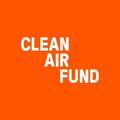
Clinician advocacy
We spoke to Dr Lucy Reynolds, a community paediatrician in Glasgow about Advocating in the media
What motivated you to start advocating for clean air through media/public campaigning? Can you walk me through your clean air advocacy journey?
Lucy’s motivation to advocate for clean air emerged from her values in social justice and concern for the environment. Her advocacy journey started 25 years ago when she was studying for a master's degree in community paediatrics. Her first experience with media came through working on a press release related to car safety, which motivated her to engage with her local MP.
Her involvement in child public health, political advocacy, and media campaigns grew as she worked in community paediatrics. In 2021, she led a series of webinars on climate change with the International Society for Social Paediatrics and Child Health (ISSOP) which further sparked her interest in climate advocacy. These webinars connected her with health professionals like Mark Hayden from Great Ormond Street Hospital, who co-organised "Ride for Their Lives," a cycling campaign from London to Glasgow aimed at raising awareness about air pollution and child health. Lucy also joined the Climate Change Working Group at the RCPCH in its advocacy subgroup, where she realised the significant role paediatricians play in highlighting the dangers of air pollution on child health.
What initiatives or campaigns have you been involved in?
Lucy has been involved in several initiatives and campaigns, particularly focusing on climate change, air quality, and the protection of children's rights. A key moment in her advocacy journey came when she was chosen to represent paediatricians in a campaign for equal protection for children, aimed at reforming Scotland's law against physical punishment. Lucy played a key role by advocating for legislative changes and presenting the college's position during consultations on a private member's bill in the Scottish Parliament. She also took part in the "Ride for Their Lives" campaign before COP26, raising awareness of the adverse health effects of air pollution on children, and proactively engaged with media outlets to strengthen her efforts. Lucy’s advocacy extends through her collaborations with organisations like Parents for Future Scotland and her involvement in Kiddical Mass bike rides, which promote safe cycling and healthier urban environments. Her crossdisciplinary work includes collaborating with charities to campaign for policy change that protect children’s rights and her advocacy often involves building relationships and networking across both health and non-health sectors.
What is the focus of your advocacy work related to air pollution?
Lucy's advocacy focuses on...
Public awareness: She works to make the public aware of how air pollution impacts child health.
Policy influence: She tries to collaborate with policymakers and charities to push for legislative changes reflecting on previous campaigns she supported with charities like NSPCC.
Education: She tries to make complex health information accessible, particularly to children and parents, ensuring that it is engaging but not overwhelming.
Have you encountered any challenges when trying to raise public awareness or media attention on the issue of air pollution?
Lucy mentioned one of the biggest challenges is limited time and energy, a reality for a lot of healthcare professionals. She emphasised the importance of building networks and collaborating with others to lighten the load- finding ways to contribute without feeling overwhelmed. Even though the pressure can feel intense at times, collaborating with others and tapping into existing initiatives can share the workload and make an impact. She also mentions a challenge in breaking through media noise, where she reflects on the importance of media training and producing impactful sound bites to ensure key messages are captured in the media.
How has your role as a doctor, and your connection to the health sector, influenced your media work?
Lucy sees herself as speaking on behalf of children, especially those who cannot advocate for themselves. Her clinical experience gives her knowledge and insights into the health impacts of air pollution on children, and she has seen first hand how the media often seeks out paediatricians specifically because they are viewed as trusted voices. She feels a duty to balance her clinical responsibilities with public health advocacy, aiming to make systemic changes that go beyond the individual patients. “I was speaking for children,” she says.
What would you do differently in your advocacy efforts?
Lucy reflected on how important media training was and how she would have done it sooner to be more effective. She recognised that learning to communicate well in both live and recorded formats had been key. Lucy highlighted the value of using “we” language, mentioning that framing issues as shared challenges instead of individual ones could have helped her keep a more collaborative tone in her early advocacy. She also pointed out how valuable it would have been to build strategic media connections from the beginning, as these relationships were crucial for getting her message out.
What have been the biggest lessons from your media advocacy work, and what advice would you give to others looking to make an impact in raising awareness about air pollution?
Lucy reflected on her biggest lessons and advised others to:
1. 2.
Network widely and build relationships: Working with charities and other health professionals can make advocacy efforts more effective - “There’s no way any of the experts could have made a difference at all without the work done by charities."
Highlight child health: Focusing on the effects of air pollution on children can create a strong argument for change- “We can have an impact on kids who
haven’t yet been born…”
Have challenging conversations: Lucy emphasised that sometimes having challenging or hostile conversations, with friends, family and colleagues can be crucial for reflecting on and gaining perspective on your advocacy. She also noted that the facts that surprise your family and friends, might be the most media worthy. For example, “people who are in cars are generally exposed to more air pollution than those cycling or walking.”
Use personal narratives: Lucy believes that combining evidence-based data with personal narratives can make a compelling case: speaking from both "the brain and the heart" can resonate with a wide audience.
Undertake media training: Learning how to convey key messages effectively in different media formats is highly useful. Lucy highlighted that usually strong soundbites will stand out and are more likely to be highlighted in the media. Balance advocacy with clinical work: Lucy highlighted that balancing clinical work with advocacy can be rewarding- “To be having an impact on a population level… helps sustain you through your career."
Positive messaging: “It’s important to mix alarming facts with positive stories, especially when talking to young people”
Listen to opposition: Being patient and understanding when talking to people who disagree can make your advocacy more convincing- “Approach people with patience and understanding, not just facts.”

Clinician advocacy

Ride for Their Lives- UK and Europe
Ride for Their Lives is a clinician-led campaign where paediatric healthcare professionals, including Dr Heather Lambert and Dr Mark Hayden, cycle between major children's hospitals across the UK and Europe to raise awareness of the health impacts of air pollution and climate change on children. By linking institutions and communities along their route, they build momentum for urgent action on clean air and a healthy environment.
Health focus
Air pollution is a major driver of respiratory illness, asthma, and long-term developmental harm in children. Ride for Their Lives brings these often-overlooked health impacts into the spotlight, advocating for stronger policy, healthcare system accountability, and childfocused environmental action.
Impact
Delivered the Healthy Climate Prescription Letter to world leaders at COP26, representing over 46 million health workers.
Influenced the development of NHS England’s Clean Air Framework, promoting sustainable healthcare practices.
Helped drive UK support for air quality targets aligned with WHO guidelines. Connected hospitals across Europe through symbolic rides, uniting clinicians and institutions behind a common cause.
Mobilised hundreds of healthcare workers to become active advocates for environmental health.
Conclusion
Ride for Their Lives transforms paediatric concern into powerful advocacy. By making the journey itself a message, they amplify the call for clean air, climate action, and a healthier future for all children.
Read more here: https://www.healthyair.org.uk/ride-for-their-lives
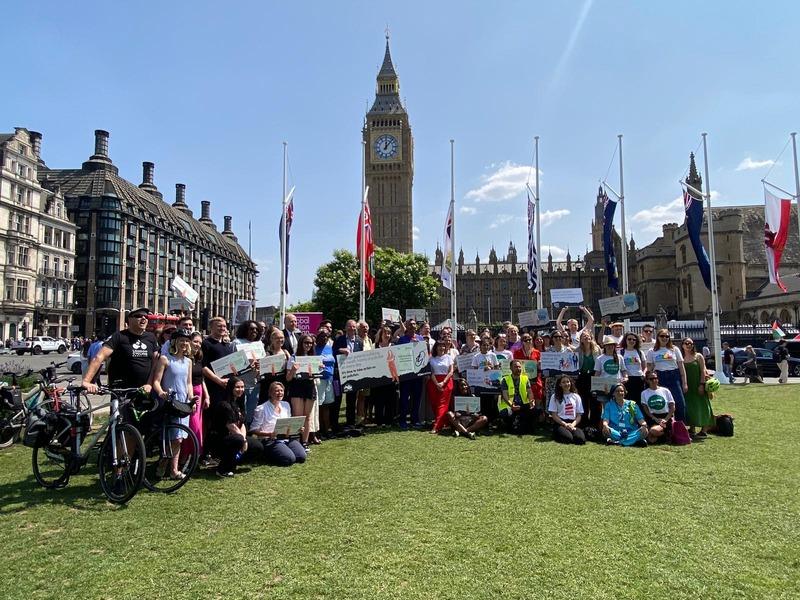
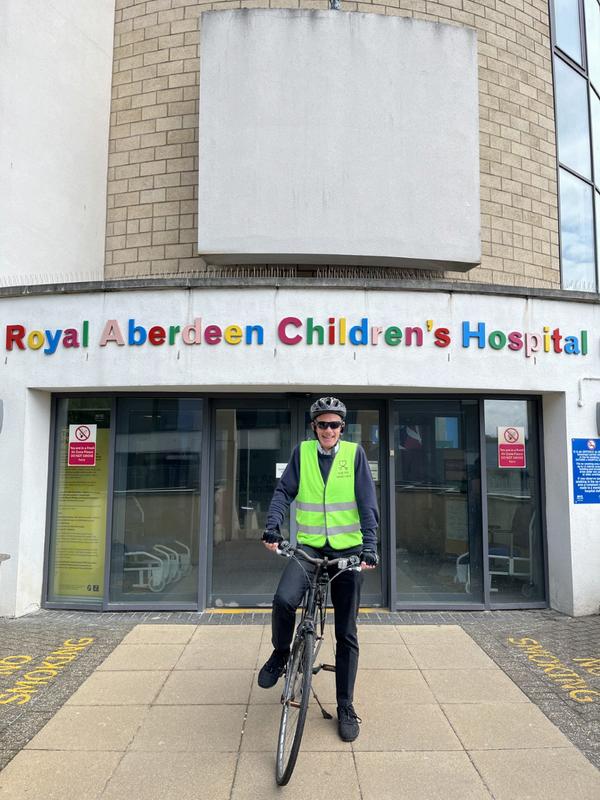

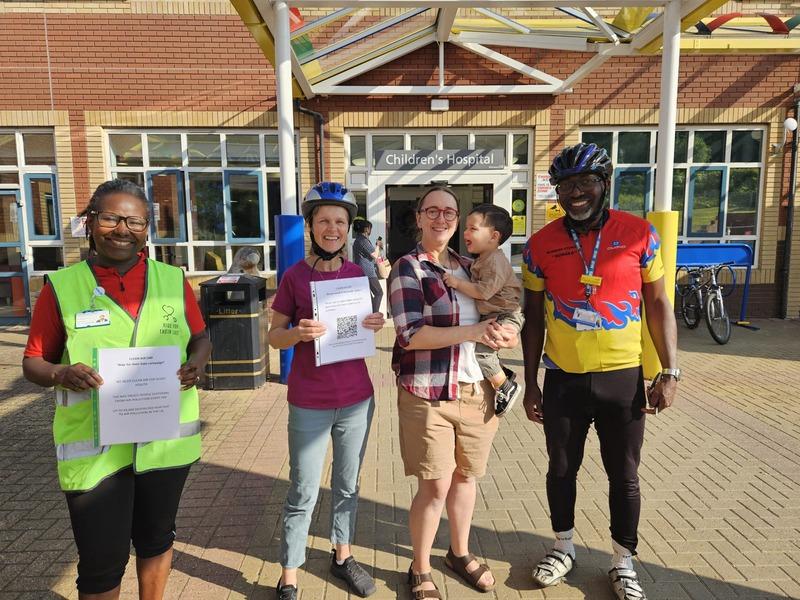
Photos from Clean Air Day 2025 Walk and Wheel event with Global Action Plan and Great Osmond Street Hospital and Synchronised Ride to Work for Clean Air Day.
Advocacy in hospitals

We spoke to Dr Babatunde Okeowo who is leading efforts in implementing the Clean Air Hospital Framework (CAHF) in Newcastle
Project
Tunde’ project examines how hospitals, as anchor institutions, can drive meaningful improvements in air quality within their communities. As part of his PhD research, Tunde focuses on embedding sustainable practices in hospital operations and evaluating their impact on air quality.
‘My project focuses on sustainable strategies to improve air quality and reduce hospital emissions. This involves comprehensive air quality monitoring and assessing the effectiveness of measures guided by the CAHF. Specifically, I am critically evaluating the CAHF’s efficiency in improving air quality and lowering carbon emissions, while also exploring the link between clean air initiatives and health trends in participating hospitals.’
The Clean Air Hospital Framework (CAHF), developed by Global Action Plan and Great Ormond Street Hospital, helps healthcare institutions reduce air pollution through practical, sustainable actions.
Location
The project is based in Newcastle, within the Newcastle upon Tyne Hospitals NHS Foundation Trust. The Royal Victoria Infirmary (RVI) and the Freeman Hospital serve as the primary case studies.
Challenges
Newcastle faces significant air quality challenges, exacerbated by the healthcare sector’s environmental footprint. The NHS accounts for over 3% of road traffic in England and approximately 5% of the UK’s greenhouse gas emissions. Recognising the healthcare sector’s dual role as both a contributor to and mitigator of air pollution, Tunde sought to address these issues. The Newcastle Trust, one of the first in the UK to declare a climate emergency, provided a strong foundation for this work.
Actions taken
Tunde collaborated with the Newcastle sustainability team to implement the CAHF, designed by Global Action Plan and Great Ormond Street Hospital. This framework outlines seven key areas for improvement, including travel, construction, energy use, and air quality monitoring. Key achievements include:
Stakeholder engagement: Building relationships with teams including sustainability and communications to raise awareness and foster collaboration. Policy implementation: Introducing an idling policy for vehicles on hospital grounds and optimising parking and travel policies to reduce air pollution. Prioritisation matrix: Developing a prioritisation matrix to focus on impactful and achievable actions, enabling rapid improvement of the CAHF compliance score from 17% to 38%.
Impact
Though ongoing, the project has already delivered notable outcomes:
Improved compliance: The Newcastle Trust increased its CAHF compliance from 17% to 38%, aiming for 70% by 2025.
Transport policy enhancements: New vehicle idling and parking policies have contributed to improved local air quality.
Raised awareness: Hospital teams are now more engaged and aware of their role in tackling air pollution.
These efforts align with the NHS's net-zero targets and provide a model for addressing both greenhouse gas emissions and air quality.
Lessons learned
Tunde identified several challenges during the project. Integrating into a large, complex organisation like the NHS was difficult, and limited resources constrained staff capacity and action implementation. Embedding air quality data into patient records a promising initiative to raise public awareness, requires a phased rollout due to its complexity.
Despite these hurdles, Tunde adopted an adaptive approach, using the "Plan-DoAct-Review" cycle from ISO standards to recalibrate actions as needed. While still in its early stages, this iterative framework offers opportunities to overcome obstacles and scale impact.
Next steps
The Newcastle Trust aims to achieve "Excellent" status under the CAHF by 2025. Tunde plans to continue evaluating the framework’s measurable impact on air quality, providing evidence to guide future strategies.
For other hospitals seeking to replicate this success, Tunde emphasised starting small and focusing on achievable actions. The prioritisation matrix, tailored to Newcastle’s challenges, can serve as a flexible guide for other trusts, helping them balance resources while maximising impact.
Tunde’s work demonstrates that even with limited resources, hospitals can take bold steps to improve air quality and protect the health of their communities.
Read more about the Clean Air Hospitals Framework here: https://www.actionforcleanair.org.uk/health/clean-air-hospital-framework
Community initiatives

We spoke to Hazel Walsh, Clinical Transformation Programme Manager at The Centre for Sustainable Healthcare and Parent at Cutteslowe Primary School about Clean Air Fridays at Cutteslowe Primary School.
Location
Oxford, United Kingdom
Challenge
The project aims to tackle air pollution around a school in Oxford by reducing vehicle idling and promoting active travel like walking and cycling. This challenge is complicated by the need to effectively communicate with a diverse group of parents and overcome practical and cultural barriers that might prevent behaviour change.
Actions taken
The school implemented "Clean Air Friday," where volunteers and parents help manage traffic around the school to reduce vehicle use close to the school...
Cones were distributed to restrict parking within a certain radius of the school and facilitate smoother traffic management.
An informative video featuring health professionals from the school community was created and distributed to highlight the health benefits of reduced air pollution.
Regular communication was maintained through the school’s parent mail system and weekly reminders.
Assemblies were held to educate children about the importance of clean air and active travel.
Impact
These initiatives have brought about significant changes. They've raised awareness about air pollution and its health effects among parents and the school community. Parents have actively joined discussions on the importance of reducing vehicle idling, even though changing behaviours has been a gradual process.
Moreover, there's a stronger sense of community and shared responsibility. Parents, students, and staff are working together to create a safer, cleaner environment for the children, fostering a spirit of collaboration. Anecdotal evidence suggests there's been a drop in cars idling near the school, showing that collective efforts are starting to make a difference. It's a positive sign of progress, even if it's not yet fully measured.
Health sector involvement
Involving health professionals was crucial as they are trusted voices within the community. Their participation lent credibility to the project and effectively
communicated the health risks associated with air pollution. The video featuring doctors, nurses, and other healthcare workers helped link the initiative directly to health benefits, making the message more compelling.
Lessons learned
They encountered practical challenges such as a shortage of cones. Engaging a diverse parent community was difficult due to language barriers and varying levels of interest. Some parents understood the initiative's goals but were reluctant to change their own behaviours. Cultural and socioeconomic factors also played a role in influencing participation rates and attitudes toward the initiative.
Conclusion/ what would you change
Greater focus on inclusive communication strategies to engage those from different cultural backgrounds, particularly non-English speaking parents More structured support from the school and incentives for volunteers to ensure sustained participation. Additional measures to address the practical challenges parents face, making it easier for them to switch to active travel modes.
Continued efforts to balance creating enough inconvenience to discourage driving without disproportionately affecting those already facing significant daily challenges.

Community initiatives

KnittingtheAir–Poplar,EastLondon
Whatitdoes
Knitting the Air is a community project that turns air pollution data into knitted artwork. Using readings from two Breathe London sensors, over 120 Poplar residents have knitted daily squares showing levels of NO₂ and PM2.5 across a full year.
Healthfocus
Poplar faces some of the worst air pollution in London, impacting child lung development and worsening asthma and heart conditions. The project brings local health data to life, raising awareness through craft in a community where air quality is a pressing health issue.
Impact
Over 1,400 data-based squares knitted Involved NHS staff from Aberfeldy Practice, who also referred patients Hosted public exhibitions, sparking conversations about pollution and health Engaged schools, GPs, and residents across Tower Hamlets
Conclusion
By turning invisible pollution into something people can see and touch, Knitting the Air connects data, health, and lived experience to inspire community action.
See more at : @knittingtheair
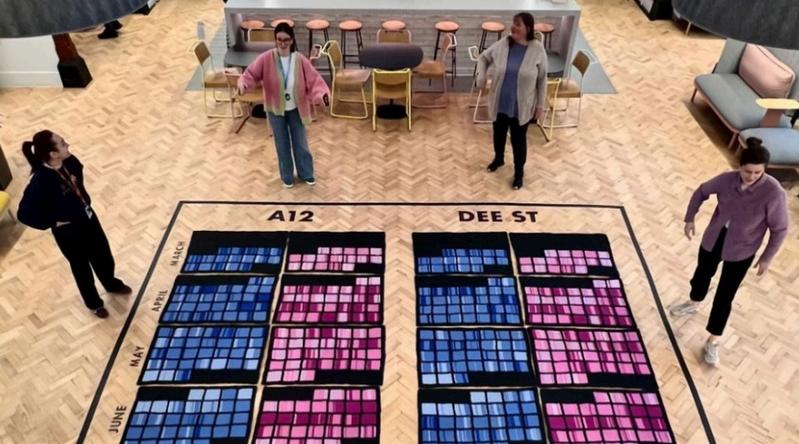
Smart Air (2024) Knitting the Air: Visualizing Air Quality Through Knitting in Poplar, UK [Online image]. Available at: https://smartairfilters.com/en/blog/knitting-the-air-visualizing-air-qualitythrough-knitting/

International Projects

Bicibús – Barcelona, Spain
What it does
The Bicibús is a parent-led initiative that enables children to cycle to school safely in supervised groups along planned routes. Created in response to high levels of air pollution in Barcelona, the project offers a clean, healthy alternative to car travel while building awareness about the environmental and health impacts of air quality on children.
Key features
• Pre-planned cycling routes with scheduled stops, similar to bus lines
• Supervision by parents and volunteers to ensure safety
• Collaboration with schools and city officials to coordinate logistics
• Emphasis on improving cycling infrastructure and road safety
• Links to classroom lessons on sustainability and health
Health focus
The Bicibús directly addresses the risks of air pollution exposure for children, including asthma and poor lung development. By reducing car traffic during school runs and encouraging active travel, the project supports better physical and mental health outcomes for children while raising awareness of air pollution’s impact on young lungs.
Impact
• Fewer car trips near schools and reduced traffic emissions
• Increased daily physical activity for children, supporting cardiovascular and mental health
• Reports of children arriving at school more alert and ready to learn
• Stronger collaboration among parents, schools, and local officials
• Model replicated internationally in cities like Portland and Edinburgh
Conclusion
The Bicibús shows how community-led, health-focused mobility solutions can reduce pollution exposure and improve child wellbeing. By combining safety, sustainability, and school engagement, the initiative demonstrates that clean air action can start with the school run and inspire global change.
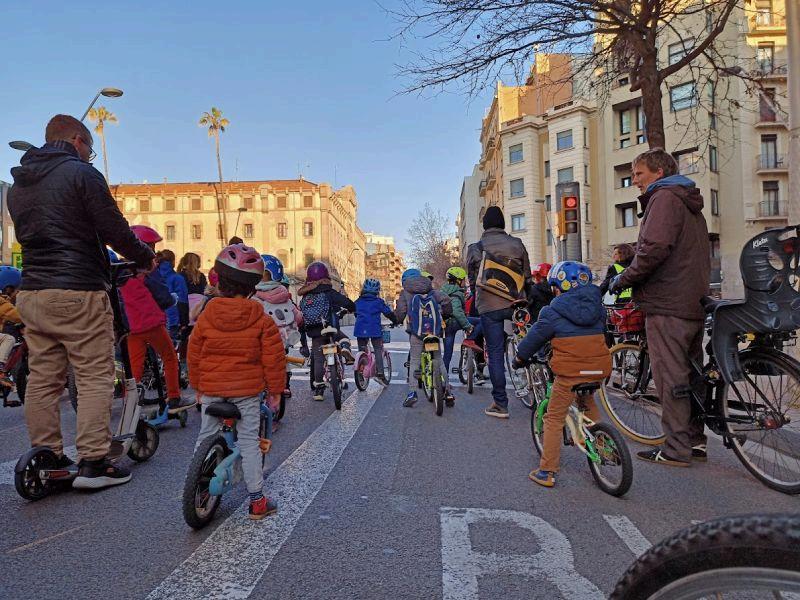
Bicibús, Children and supporting adults riding a bike‑bus through a city street [Photograph]. Available at: https://bicibus.eu/en/
Read more here: https://bicibus.eu/en/

International Projects

Hoy No Circula – Mexico City, Mexico
What it does
Hoy No Circula is a vehicle restriction programme launched in Mexico City to reduce air pollution from traffic. Based on license plate numbers, cars are prohibited from driving one weekday each week. The goal is to lower emissions, improve air quality, and raise public awareness of pollution-related health risks.
Key features
Applies to all vehicles including private cars, Implemented during high pollution periods and permanently for weekday traffic
Designed to reduce traffic congestion and lower levels of pollutants like PM₂.₅ Encourages use of public transport and active transport options
Health focus
Although not originally framed as a health intervention, the programme responds to serious health risks from air pollution, including asthma, cardiovascular disease, and premature death. Children are particularly vulnerable, and reducing trafficrelated emissions helps lower their exposure to harmful pollutants during school commutes and outdoor activities.
Impact
Initial reductions in pollution levels on restricted days
Increased public awareness about the link between traffic and health
Mixed long-term results due to behaviour changes like purchasing additional vehicles
Has helped pave the way for stricter emissions standards and clean air policies
Conclusion
Hoy No Circula marked an early and ambitious attempt to address urban air pollution through vehicle restrictions. While the policy faced limitations, it raised public consciousness and supported broader reforms in environmental and public health policy. Its legacy lies in showing how traffic regulation can serve as a stepping stone toward healthier, more sustainable urban living.

Getty Images , Photo labelled “Hoy No Circula” [Photograph] Getty Images Available at: Getty Images
Read more here: https://www.ccacoalition.org/news/mexicos-mega-city-advancesfight-cleaner-air

International Projects

Green Corridors – Medellín, Colombia
What it does
Medellín’s Corredores Verdes (Green Corridors) initiative, launched in 2016, has transformed major roads and urban heat islands into green, shaded corridors to reduce air pollution and improve public health. Urban heat islands are areas in cities that become significantly warmer than surrounding areas because buildings, roads, and other hard surfaces absorb and retain heat, especially where there is little vegetation. By adding trees and plants along busy routes, the project cools these hotspots, improves air quality, and supports healthier environments.
Key features
• Over 30 corridors created along roads, waterways, and pedestrian routes
• More than 8,000 trees and 350,000 shrubs planted to capture pollutants and reduce PM₂.₅
• Focus on traffic-heavy areas and zones near schools and hospitals
• Encourages walking and cycling through shaded, cooler routes
Health focus
Though primarily environmental, the project supports child and public health by lowering exposure to harmful air pollutants. It benefits children in particular by targeting areas near schools, promoting active travel, and reducing pollutionrelated risks such as asthma and poor lung development.
Impact
• Local air quality improvements and reduced surface temperatures
• Safer, more attractive pedestrian routes for daily commutes
• Increased public engagement with air pollution and health issues
• Recognition as a global model for urban greening and clean air action
Conclusion
Medellín’s Green Corridors show how urban nature-based solutions can deliver both environmental and health benefits. By focusing on polluted, high-traffic zones and improving walkability, the project not only helps clean the air but also supports healthier lifestyles, especially for children, while making the city more liveable and resilient.

C40 Knowledge Hub (n.d.) Medellín’s interconnected green corridors [Photograph]. Available at: https://www.c40knowledgehub.org/s/article/Cities100-Medellin-sinterconnected-green-corridors
Read more at: https://www.c40knowledgehub.org/s/article/Cities100-Medellin-sinterconnected-green-corridors?language=en US

International Projects

Breathe Cities – Global (Accra, Bangkok, Bogotá, London, Mexico City, and more)
What it does
Breathe Cities is a global initiative designed to help cities reduce harmful air pollution, cut carbon emissions, and improve public health. The programme provides funding, technical support, and resources to local governments, NGOs, community groups, and researchers. It focuses on expanding local air quality data through innovative monitoring technologies, offering evidence to guide effective policy decisions. Breathe Cities also supports city officials in developing and enforcing clean air policies by providing capacity building and expert technical assistance. At the same time, it engages local communities, particularly those most affected by pollution, to raise awareness and build public support for clean air actions. The programme fosters knowledge exchange by sharing lessons learned across participating cities, enabling faster adoption of successful strategies worldwide.
The initiative operates in diverse cities including Accra, Bangkok, Bogotá, Brussels, Jakarta, Johannesburg, London, Mexico City, Milan, Nairobi, Paris, Rio de Janeiro, Sofia, and Warsaw, tailoring solutions to local needs and challenges.
Health focus
Breathe Cities highlights air pollution as a critical public health and social justice issue. Exposure to polluted air is linked to asthma, impaired lung development in children, cardiovascular disease, and premature death. The programme uses local health data to demonstrate these impacts and to strengthen the case for health-centred air quality policies.
Impact
Breathe Cities supports cities in implementing measures such as clean air zones, promoting cleaner transport options, and encouraging community-led health campaigns. It equips cities with tools to monitor pollution, identify key sources, and communicate health risks effectively to residents and policymakers. A projected 30 percent reduction in air pollution across participating cities by 2030 would lead to:
55,000 premature deaths prevented
111,000 new cases of asthma in children avoided
$147 billion saved in avoided hospitalisations and deaths
394 megatons of CO₂ equivalent emissions reduced
Conclusion
By combining data-driven approaches, policy support, and community engagement, Breathe Cities helps create healthier, more sustainable urban environments. The programme’s focus on children’s health and equity ensures that the benefits of cleaner air reach those who need it most, contributing to safer and more resilient cities worldwide.
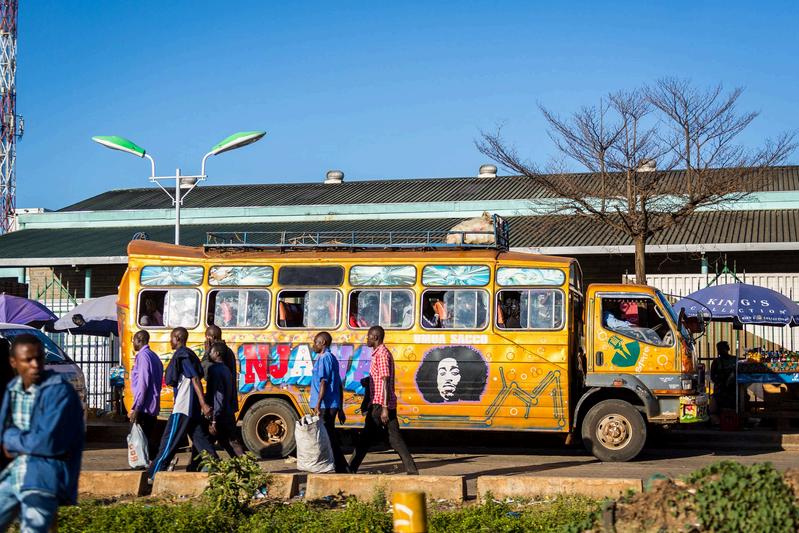
Sopotnicka, E, Commuters using bus in Nairobi, Kenya [Photograph]. iStock/Clean Air Fund. Available at: cleanairfund.org/news-item/6 african cities by 2040/
Read more here: https://breathecities.org

Monitoring and technology

SAMHE – United Kingdom
What it does
The Schools’ Air quality Monitoring for Health and Education (SAMHE) project equips schools across the UK with indoor air quality sensors and an interactive digital platform to monitor, understand, and improve classroom air quality. The initiative aims to engage students and teachers in science-based learning while generating large-scale data on indoor pollution levels in educational settings.
SAMHE is a collaboration between leading universities, health experts, and environmental scientists, supported by the UK Health Security Agency. It combines citizen science with formal research, involving schools in collecting real-time data on CO₂, temperature, humidity, and particulate matter (PM2.5 and PM10). The findings help both students and policymakers better understand how air quality affects health, concentration, and learning outcomes.
Health focus
Poor air quality in schools can affect children's respiratory health, increase the risk of asthma, and reduce cognitive performance. SAMHE links environmental education with child health by making invisible pollution visible and actionable, encouraging schools to improve ventilation and reduce exposure.
Impact
Over 1,000 UK schools have joined the project, helping build one of the largest datasets on school air quality. Early insights have led to simple but effective interventions, such as improved ventilation and better classroom layouts. Teachers report increased student awareness and interest in health and environmental science. The data also informs national health guidance and supports efforts to design healthier school environments
Conclusion
SAMHE is an innovative example of how education, health, and science can intersect to improve child well-being. By empowering schools with real-time data and engaging children as citizen scientists, it builds both awareness and actionable knowledge about air quality and its impact on learning and health.
Read more here: https://www.samhe.org.uk

Monitoring and technology

Air Aware Labs
Air Aware Labs (AAL) is a UK-based tech start up working at the intersection of health, technology and environmental science. They’re on a mission to empower people with data driven choices about the air they breathe.
Air pollution is a global health emergency, contributing to 8 million deaths annually and costing the global economy $3 trillion. In the UK alone, it's linked to around 36,000 premature deaths each year and contributes to rising cases of asthma, heart disease, and other chronic conditions. The app, AirTrack, offers a proactive, personalised solution by turning complex environmental data into clear, personal insights. Using AI and high-resolution air quality mapping, AirTrack helps individuals reduce exposure and protect long-term health.
“We want people to enjoy the urban environment, exercise safely and feel confident raising their children—reducing the impact of air pollution on their family’s health.” Louise Thomas, CEO & Co-Founder
Global reach
“Building Air Aware Labs has been like putting a field lab in your pocket. Air pollution is invisible, but with AirTrack, we make it visible—and change lives with that insight.” Will Hicks, CSO & Co-Founder
What began as an idea has grown into an international tool for cleaner living. AAL supports global advocacy through initiatives like Every Breath Counts and Camden Year of Clean Air for Schools.
Future goals
Support clinical research with environmental health data
Expand work with NHS trusts and public health teams
Influence urban planning and policy through open data advocacy
The Tool: AirTrack – Know Your Air
AirTrack is a mobile app providing real time, personalised air quality data. Using AI and detailed environmental datasets, it helps users monitor and reduce exposure to pollutants like PM2.5 and NO2.
Key features
Tracks air quality during daily activities (e.g. walking, running, cycling)
Offers hyper-local insights, accurate to the street
Integrates with Strava, Google Health Connect, Apple Health
Supports people with allergies, respiratory conditions, and young children in making safer route choices
AirTrack is highly scalable, with users in 100+ countries, across 26 sports, tracking over 150,000 activities, and more than 800 app downloads to date.
Clinical relevance: Clinicians and healthcare professionals can utilise AirTrack as a preventive and management tool in patient care:
For patients with asthma, COPD, or cardiovascular issues, AirTrack can guide behavioural changes to minimise exposure through time and route changes in their outdoor activities
In paediatrics, it helps families plan outdoor playtime and activities in cleaner air times
Allergy clinics could use AirTrack data to correlate symptoms with pollution exposure
Occupational health specialists can advise active commuters or outdoor workers using the app’s data and insights
Health promotion initiatives in GP practices or hospital trusts can include AirTrack in digital wellbeing packages
AirTrack data can be embedded into broader healthcare platforms via API, supporting exposure tracking and health outcomes research.
Impact
Parents in urban areas can use AirTrack to adjust school run routes and campaign for interventions such as School Streets
Runners and cyclists can change training times and routes based on air quality data to reduce exposure, improve performance and reduce long-term health impact
Employers can use AirTrack through Heka and HealthKey employee wellbeing platforms or our Enterprise solution
Air Aware Labs invite clinicians, researchers, schools, and families to explore AirTrack and support healthier living.
Download AirTrack – free on mobile (Strava, Apple Health, Google Fit)
Read more here: https://www.airawarelabs.com/airtrack

Monitoring and technology

Clean Air in Cities
App/Website giving air pollution monitoring data, trends and alerts.
What it does
Developed by Clean Air in London, the app uses the Clean Air in Cities (Birkett) Index™ to provide real time and long term data on PM₂.₅ (fine particulates) and ozone exposure for local areas in England. It reports annual mean levels of PM2.5 for local and unitary authorities and regions in England, together with the percentage of total deaths attributable to human-made PM2.5. It also calculates continually the pro rata year-to-date number of deaths attributable to human-made PM2.5 and the time to the next such death for each area
Key features:
Live hourly concentrations of PM₂.₅ and O₃ via OpenWeather.
Short term Air Pollution Alert Index (24 hour forecasts).
Estimates of long term exposure: percent of total deaths attributable to PM₂.₅, annual average concentrations, year to date attributable deaths, and predicted time until the next attributable death.
How the app can help paediatric practice
Asthma management - Identify pollution spikes; advise on avoiding outdoor activity or staying indoors. Supports simulated conversations practice from RCPCH resources.
Parental education - Empower caregivers with tangible data and visual comparisons to WHO guidelines. Offers data to support behaviour change. Community & policy advocacy - Use local PM₂.₅ data to influence school zones, clean air streets, wood-burning bans, and transport planning.
Interdisciplinary engagement - Helps bridge conversations with school nurses, local authorities, and parents via evidence-backed air quality monitoring.
Impact
Raises awareness: The app combats "widespread ignorance" about air pollution’s risks evidenced by surveys of MPs who underestimated its impact
Clinical conversations: Paediatricians receive training via RCPCH (e.g. webinars, the Air Pollution Companion toolkit) to confidently discuss air pollution with children and caregivers
Policy momentum: Data from apps like this contribute to expanding clean air zones, school street closures (e.g. Islington), and campaigns like Mums for Lungs
Behavioural change: Presentation of risk in relatable terms has the potential to prompt protective family behaviour.
Recommendations for paediatricians
Incorporate into clinic: Display app screenshots/posters in waiting rooms; reference live data during consultations, especially for respiratory cases. Use RCPCH tools: Combine app data with Air Pollution Companion and simulated conversation modules for more effective patient dialogue. Screen for air risk: Check app alerts or local data before outdoor activities e.g. school outings or sports and advise accordingly. Amplify advocacy: Work with school boards and councils using app-derived data to support interventions like school street timing or cleaner transport routes.
Engage families: Encourage families to add their home postcode, track their local exposures, and share pollution alerts via built-in notifications.
Conclusion
The Clean Air in Cities app is a practical, data-rich tool that integrates seamlessly into paediatric healthcare. By offering real-time exposure insights and long-term health context, it empowers paediatricians to:
enhance patient education and management integrate air quality into routine clinical care support broader public health advocacy
Read more here: https://cleanair.london/cleanaircities/
Monitoring and technology

Inter disciplinary systemic action at Imperial College London
Dr Audrey de Nazelle is a Senior Lecturer at the Centre of Environmental Policy. She is co-chair of the International Society for Environmental Epidemiology (ISEE) Policy Committee, and outgoing chair and founder of Imperial's Network of Excellence on Air Quality (NExAir). Dr de Nazelle leads the London-based case study for the EU-FP7 project Physical Activity through Sustainable Transport Approaches (PASTA)
Her research is at the intersection of environmental sciences, health behaviour, transportation, and urban planning. Dr de Nazelle’s research and writing pushes decision makers towards health promoting built environments and policies. It involves novel and holistic approaches to assessing behavioural, environmental and health impacts of urban plans and policies.
Dr de Nazelle’s work on risk assessment and exposure science highlights that individuals have limited power to protect themselves against the pervasive crisis that is air pollution. Real progress demands bold policies, collective action, and collaboration across disciplines and sectors.
Policy vs technological fixes
While technological solutions like electric vehicles or air quality apps can offer incremental improvements, they are often limited in scope, yield few co-benefits, and may even entrench harmful systems or shift pollution elsewhere. For example, the electrification of vehicles can reduce tailpipe emissions but does little to address non-exhaust particulate matter, car dependency, or the environmental injustice of rare metal extraction for batteries.
Rather than relying solely on technological fixes, transformative change comes through systemic political action, particularly urban policies that reduce car dependence and create walkable, cyclable, and transit-oriented environments. Such strategies not only reduce emissions but also promote physical activity, improve safety, and expand green space, delivering widespread health and social benefits.
The drivers of human behaviour are complex and are at once individual, economic, social, environmental, cultural and contextual. Current information giving approaches can be complemented by seeking to activate social norms, establishing emotional connection and harnessing feelings of collective responsibility. Interventions and recommendations should be cognizant of unintended consequences such as reducing physical activity as seen with air pollution alerts, or shifting responsibility away from government action and onto individuals.
Equity and justice
Air pollution disproportionately impacts deprived communities, who typically contribute the least to it. These populations often have lower rates of car ownership and travel shorter distances by car, yet are more exposed and vulnerable to its effects. Ironically, car-reduction policies are sometimes resisted on the grounds of unfairness to low-income groups. Dr de Nazelle argues that this framing ignores the deeper structural injustices and underlines the importance of designing equitable policies that ensure attractive, affordable alternatives to car use and include community participation in urban planning.
Joined up thinking
A recurring obstacle in air pollution policy is the lack of integrated thinking across policy areas. Many current policies are short-sighted, narrowly targeted at meeting regulatory thresholds, and fail to address broader determinants of health and environmental quality. To truly deliver on the potential of air pollution policies, what’s needed is a holistic, systems-thinking approach that accounts for feedback effects, trade-offs, and co-benefits across sectors.
This calls for cross-disciplinary collaboration between physical scientists, health researchers, social scientists, and policy experts. Dr de Nazelle emphasizes that understanding the complex interlinkages between urban form, behaviour, environmental exposure, political processes, and health requires co-created research that is grounded in real world contexts. Academic research must be designed alongside policymakers and stakeholders to ensure relevance, uptake, and impact.
Sustainable, healthy cities
Ultimately, transformative solutions to air pollution must be embedded in a broader vision of sustainable and equitable urban environments. Collaboration across academic disciplines plays a pivotal role, not just in understanding the issues, but in shaping actionable solutions that build cities people want to live, work, and thrive in.
Investment should not be short sighted or led by an industry elite, instead climate resilience should be built into urban development planning aimed at activating both short and long term health and wellbeing benefits for all those involved. Safe active transport, public open spaces encouraging social interaction, accessible public transport and low-carbon healthy food should all be a mainstay of development strategy. Co-production and systems thinking are holistic approaches that researchers, policymakers and stakeholders alike can embrace to create a common language and build a healthier future for people and the planet.
You can watch Dr de Nazelle talking at the World Economic Forum about rewiring the urban landscape for healthy mobility: https://www.youtube.com/watch? v=3AgY-YfZz s
Read more here: https://link.springer.com/article/10.1007/s11625-021-01038-2#Fig2
